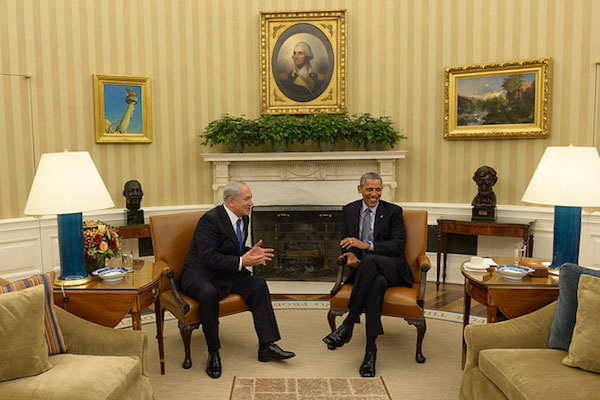By accepting that the two-state solution will just have to wait until Israel is ready to accept it, the White House has effectively conceded to Netanyahu’s strategy: declare support for two states — in theory — while continuing to deny Palestinians their most basic rights and liberties.

Benjamin Netanyahu’s strategy for defeating the prospect of Palestinian statehood has always been to stall. Sure, he introduced a few tactical roadblocks along the way like “security zones” and demanding recognition of Israel as a Jewish state, but the wider strategy has always been to feign engagement until momentum swings back in his favor.
The strategy has worked pretty well so far, largely because the formulation for peace on the table and the process established for reaching it was, it now appears, doomed to fail. Israel’s current crop of leaders will never agree to the creation of a truly sovereign Palestinian state or a just resolution to the refugee problem, two issues on which no Palestinian leadership will ever compromise.
All Netanyahu has had to do is appear like he is willing to try but never actually budge too far, blame domestic political considerations and geopolitical turmoil for his hesitance to go out on a limb, and declare that despite his best intentions there is no partner for peace. Or maybe the timing is off. Or maybe ISIS. Or Iran.
For years the prime minister has been fairly open about his opposition to Palestinian statehood, it’s just that he has learned to use dog whistle terms to talk about it, and even then generally only in Hebrew. For instance, early last summer, before the Gaza war, Netanyahu said in a rare question-and-answer portion of a press conference that “there cannot be a situation, under any agreement, in which we relinquish security control of the territory west of the River Jordan.” The prime minister’s bravado went right over the heads of most of the media at the time.
During the 2015 election campaign, Netanyahu hinted at and then said explicitly, albeit reluctantly and only in Hebrew, that a Palestinian state will not be born on his watch. The world noticed that time but only because elections were in full swing, and the prime minister was eventually forced to roll back his statement. He does support Palestinian statehood in principle, Netanyahu clarified once his victory was sealed and electoral concerns were no longer, it’s just that “under the present circumstances … the implementation of that vision is not relevant right now.”
In other words, the prime minister supports the two-state solution in principle but not in practice.

The White House at the time responded with some of the harshest rhetoric we have seen toward Israeli intransigence in years. The United States will be forced to “reevaluate its approach” to the peace process, the Obama administration told anybody who would listen in the weeks following Netanyahu’s reelection in March.
Now, we are finally getting a glimpse of exactly what that means. In a series of briefings, conference calls and interviews with reporters in the days leading up to Netanyahu’s visit to Washington this week, senior administration officials said they have accepted that the two-state solution is not a near-term possibility in practice, and that in lieu of progress it expects Netanyahu to take concrete steps toward ensuring it remains the only option on the table in principle.
In other words, the White House has adopted, or at least accepted, the Netanyahu approach to (not) resolving the Israeli-Palestinian conflict.
That’s how Netanyahu won. Here’s how he can be defeated.

The United States’s historical approach to the Israeli-Palestinian conflict is in many ways at odds with its own values. Whereas American political thought is generally centered on the idea of individual rights and liberties, when it comes to Israel every U.S. administration has prioritized national rights at the expense of the individual.
There is a logic to that way of thinking, especially when considering the historical context of the Holocaust and the need for a Jewish homeland to safeguard against future collective threats. That logic also casts aside the inherent injustice of a state that belongs to only one of the two ethno-religious groups that comprise its citizens.
Under the current worldview propagated by the White House, preserving Israel as a “Jewish and democratic state” is more important than ensuring that all Israelis and Palestinians: have equal rights and due process, access to equal opportunity, basic civil liberties like free speech and movement, and the right to choose and hold accountable one’s rulers.
One way to reconcile these seemingly diametric needs is to reevaluate the very conceptions responsible for rendering the two-state solution as the only acceptable resolution. By prioritizing individual civil liberties and rights over national self-determination, thereby redefining the problems any peace process aims to resolve, new formulations for reaching a resolution will reveal themselves.
Instead of first defining the framework of a resolution and then forcing each side to compromise their respective needs in order to contort themselves into its confines, the United States — or another world power — would be wise to first establish the fundamental needs and basic rights of everyone directly affected by the conflict, the occupation and the peace process itself. Or in other words, start treating the occupation and the violence it perpetuates as a civil rights issue and not a nationalist or diplomatic affair.

Doing so could open up new paths for resolving the Israeli-Palestinian conflict, in any number of political entities or configurations that can truly meet the needs and respect the rights of everyone involved — including by continuing to act as a safe haven for the Jewish people.
A one-state outcome “is filled with greater risks for Israel as a Jewish state and a democracy,” senior Obama advisor Ben Rhodes told Haaretz’s Barak Ravid this past week. That is true: a one-state outcome is full of risks, for everyone involved.
But the two-state solution was supposed to end the occupation, guarantee security for Israel and realize national self-determination and sovereignty for the Palestinians. It has failed to do so. All the the two-state process has succeeded in achieving is the creation of a framework for systematically denying basic rights and liberties to half of the population living under Israeli control, all while failing to provide security for anybody.
Perpetuating a status quo of inequality and injustice so that the vision of a two-state solution can survive is one of the worst outcomes President Obama leave as his legacy. Doing so would hand a huge victory to Netanyahu, who has built a very successful career by standing in the way of a just resolution to the conflict. Even worse, it leaves Palestinians under foreign military occupation and abandons both sides as they nervously await the next explosion of violence. Luckily, it’s not the only way.


